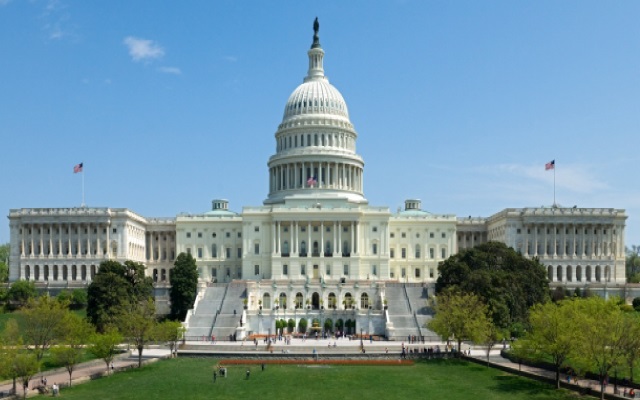
by Elizabeth Troutman | Mar 17, 2024 | Economy, News
By Elizabeth Troutman |
Two House Republicans and one Democrat from Arizona wrote to IRS Commissioner Daniel Werfel asking the agency to reconsider its decision to subject the Arizona Families Tax Rebate Program to federal income taxation.
Representatives David Schweikert, R-Ariz., Juan Ciscomani, R-Ariz., and Greg Stanton, D-Ariz., sent the letter Wednesday.
“We urge the IRS to reconsider its determination and provide expedited relief to compliant Arizonan taxpayers who have already filed their 2023 tax returns,” the three wrote.
More than 700,000 Arizona taxpayers were eligible to receive a one-time tax rebate as the state continues to recover from historic inflation levels that placed severe financial strain on families across the state, according to the representatives’ news release.
“The country is poorer now than it was three years ago, and Arizonans are no different, facing the brunt of financial pressure with supermarket prices now nearly 25% higher than in January 2020, for example,” the letter says. “State officials acted in good faith with the reasonably available information to provide more than 700,000 households with much-needed relief from price increases on everyday goods and services.”
Tax rebates enacted by 21 states were determined to be tax exempt in guidance issued by the IRS in February 2023, Schweikert, Ciscomani, and Stanton wrote. Though Arizona’s tax rebate wasn’t signed into law for another three months, the IRS extended its decision to make the rebate taxable past the period when the state issued payments, according to the letter.
“In December 2023, the IRS relayed its decision orally through a video meeting, providing no written explanation until February 15, 2024, eighteen days after the start of tax season, and only in response to a letter from the Arizona Attorney General challenging the decision,” the letter says.
Arizona taxpayers are estimated to owe $20.8 million in extra federal taxes due to the IRS’ inconsistent rationale in failing to specify the factual and legal basis for the 21 states’ rebates and payments that were deemed nontaxable in 2022, according to the representatives.
“The inconsistency and delay in communication have resulted in undue financial strain on Arizonans,” the letter says.
Elizabeth Troutman is a reporter for AZ Free News. You can send her news tips using this link.

by Daniel Stefanski | Mar 14, 2024 | Economy, News
By Daniel Stefanski |
The Arizona Legislature continues to work on solutions to crack down on organized retail theft across the state.
Last week, the Arizona Senate overwhelmingly passed SB 1411 with a 22-4 vote (with four members not voting). The bill would “require the Attorney General to establish the Organized Retail Theft Task Force to combat crimes that relate to stealing, embezzling or obtaining retail merchandise by fraud, false pretenses or other illegal means for the purposes of reselling the items” – according to the purpose from the chamber.
After the vote, Senator David Gowan, the bill’s sponsor, issued the following statement: “California has been forced to invest hundreds of millions of dollars to fight an enormous rise in organized retail crime because of their liberal policies that oppose holding people accountable for breaking the law. Businesses have been forced to shut down and pull out of the state. We don’t want to turn into California, but unfortunately Arizona is also experiencing a rise in these crimes. We need to get ahead of the issue to prevent going down the same path, which is why I sponsored SB 1411 to establish a task force to combat crimes that relate to stealing, embezzling, or obtaining retail merchandise by fraud, false pretenses, or other illegal means for the purposes of reselling the items.”
Gowan added, “The task force will be comprised of federal, state, and local law enforcement, in order to use their combined skills, expertise, and resources more effectively. This bill passed out of the Senate with strong bipartisan support. We all want to protect our businesses and keep our communities safe from theft.”
Last month, the bill passed the Senate Committee on Military Affairs, Public Safety and Border Security with a 7-0 tally.
Senator Janae Shamp and Representative Justin Wilmeth joined as co-sponsors for the legislation.
On the Arizona Legislature’s Request to Speak system, representatives from the Arizona Retailers Association, Arizona Attorney General’s Office, Arizona Food Marketing Alliance, Greater Phoenix Chamber of Commerce, and CVS Health signed in in support of the proposal.
SB 1411 now heads to the Arizona House of Representatives for consideration.
The efforts to shut down organized retail theft crimes continue the state’s already strong reputation on this front. Arizona already has another Organized Retail Crime Task Force, which commenced under former Attorney General Mark Brnovich’s administration and is also housed in the State Attorney General’s Office.
In December 2021, Brnovich wrote an opinion piece for the Wall Street Journal, warning would-be criminals of his office’s efforts to investigate and prosecute these offenses – especially in the wake of the lawlessness in Arizona’s neighboring state to the west. He wrote, “As Arizona’s attorney general, I have refused to capitulate to the lawless mob…We expect our efforts will deter such theft and hope our task force becomes a model for California and other states.”
Maricopa County Attorney Rachel Mitchell also has a strong presence against organized retail theft. In 2023, her office announced that it had made 354 bookings over these crimes, which was the most in the county since 2020. Additionally, in November 2023, Mitchell started a ‘Safe Shopping’ Campaign “to stop this fast-growing category of lawlessness.” Mitchell said, “Here’s what I say to the thieves who commit these crimes: we will find you, you will be arrested, and we will prosecute you to the fullest extent of the law.”
Daniel Stefanski is a reporter for AZ Free News. You can send him news tips using this link.

by Elizabeth Troutman | Mar 5, 2024 | Economy, News
By Elizabeth Troutman |
Four Arizona cities made it onto a list of America’s least financially distressed cities.
Last month, WalletHub released the results of their comparison of the 100 largest cities without data limitations across nine key metrics. The personal-finance website determined cities are the most and least financially distressed in light of inflation making it more difficult for Americans to keep up with payments on their loans and lines of credit.
Glendale was 92nd on the list, followed by Chandler at 97, Gilbert at 98, and Scottsdale at 99.
“Getting out of the downward spiral of financial distress is no easy feat,” WalletHub Analyst Cassandra Happe said in a news release. “You may get temporary relief from your lenders by not having to make payments, but all the while interest will keep building up, making the debt even harder to pay off.”
“People who find themselves in financial distress should budget carefully, cut non-essential expenses, and pursue strategies like debt consolidation or debt management to get their situation under control,” she continued.
Chicago, Illinois was the city with the most financial stress.
“It seems that in the Windy City, people’s financial security is also blowing away,” Happe said. “The share of Chicago residents who are allowed to skip debt payments due to financial difficulties went up by nearly 30% between Q4 2022 and Q4 2023.”
Additionally, Chicago residents had the third-most accounts in distress per person, according to Happe.
“Financial distress may increase further, too, as Chicago has some of the highest Google search interest in the country for terms like ‘debt’ and ‘loans,’ which indicates that people need to borrow even more,” she said.
After Chicago, Houston, Texas had the second most financial stress, followed by New York City, Los Angeles, Dallas, Las Vegas, San Antonio, Atlanta, Riverside, and Jacksonville.
Elizabeth Troutman is a reporter for AZ Free News. You can send her news tips using this link.

by Corinne Murdock | Mar 4, 2024 | Economy, News
By Corinne Murdock |
There were over 800 illegal immigrant children released to sponsors in Arizona in the last fiscal year, which would result in an estimated cost of over $10 million to educate them.
This estimate comes from Joint Legislative Budget Committee (JLBC) data, in which average per-pupil spending in 2022 derived from state, local, and federal funding, adjusted for inflation, was over $11,700. The Office of Refugee Resettlement (ORR) reported that there were 861 unaccompanied children released to sponsors in the 2023 fiscal year, which runs from October 2022 to September 2023. Altogether, that amounts to over $10 million.
Per the latest immigration data, another 368 unaccompanied children were released to sponsors from last October to December. JLBC estimated per-pupil spending last year, adjusted for inflation, to sit at about $12,000, and spending in 2024 to sit at about $11,700.
Since the 2021 fiscal year, there have been over 2,600 illegal immigrant children released to sponsors. That’s about 1,000 more in four years than the entire total for the six years spanning the 2015 fiscal year to the 2020 fiscal year (just over 1,700).
Under 2022 costs, that amounts to over $28.6 million. The estimated 2023 costs, adjusted for inflation, amounts to over $31.2 million, with a return to about $28.6 million under 2024 estimated costs.
Nationwide, there were about 113,500 illegal immigrant children released to sponsors in the last fiscal year. That’s a decline from the 2022 fiscal year, about 127,500, but remains a significant increase from all other years prior.
In the first four months of this fiscal year, there have been about 46,300 unaccompanied minors encountered along the southwest border. Border encounter data reveals that there have been over 468,180 unaccompanied minors since President Joe Biden took office.
Encounter totals for accompanied minors register far lower. There have been just over 500 encounters of accompanied minors in the first four months of this fiscal year, and over 7,800 in total since Biden took office.
These latest estimates are just a portion of total migrant children in the education system, and consist of only those reported. In 2022, there were over 90,000 students characterized as English Language Learners (ELLs) in Arizona. Using 2022 education costs, that amounts to over $1 billion.
Corinne Murdock is a reporter for AZ Free News. Follow her latest on Twitter, or email tips to corinne@azfreenews.com.

by Daniel Stefanski | Feb 28, 2024 | Economy, News
By Daniel Stefanski |
Arizona legislative Republicans are working to lower gas prices for Arizonans at the pump.
Last week, the Arizona Senate approved SB 1064, sponsored by Senator Justine Wadsack, which “adds gasoline fuel reformulation options for all gasoline sold or offered for sale for use in motor vehicles in a county with a population of 1,200,000 or more persons and any portion of a county contained in outlined areas,” according to the purpose provided by the chamber.
The bipartisan vote in the Senate was 17-11 (with two members not voting) in favor of the legislation.
“From gasoline to groceries, electricity, housing, and every other basic necessity, Arizonans are paying thousands of dollars more per year to maintain the same quality of life they had just before Joe Biden took office. While we can’t prevent his implementation of the reckless policies that are hurting hardworking families, senior citizens, and young adults, we can help Arizonans keep more of their hard-earned dollars through commonsense solutions like SB 1064. I’m hopeful this legislation will be signed into law because it is the right move to make to improve the lives of our citizens.”
According to the press release from the Arizona Senate, the state is “currently required to provide drivers in Maricopa County [with] a specific fuel blend for cooler season months and a different fuel blend specific for warmer season months.” SB 1064, if signed into law, would “establish a free market solution by allowing as many fuel blends as possible.” Republicans have “identified eight comparable blends.”
Earlier this month, the bill passed out of the Senate Committee on Natural Resources, Energy and Water with a 4-1 tally. Two members on the panel did not vote.
Arizona Republicans have long been working on solutions to the state’s high costs for energy– especially since spring 2023. It was then that they learned the Governor’s Office was convinced by the EPA not to submit a waiver for an “alternative fuel type to provide an adequate supply for drivers and preventing a hike in gas prices,” despite oil companies warning state officials of significant refinery shutdowns and past Arizona Governors applying for and receiving that opportunity. According to Senate Republicans, “this catastrophe reduced the supply of the CBG (fuel blend)” produced for the state during the spring and summer.
Last year, Senator Jake Hoffman unleashed a blistering rebuke of Hobbs’ reported failure “to do the right thing by requesting this waiver to allow prices at the pump to drop.” Hoffman’s statement followed the aforementioned accounts of a letter that had been sent to Hobbs in March by independent petroleum refiner HF Sinclair, warning the state’s chief executive “of a critical supply shortage in Arizona due to an unexpected equipment failure stopping the production of CBG required by the Biden Administration in Maricopa County, as well as parts of Pinal and Yavapai Counties.”
At the time, Hoffman said, “Katie Hobbs’ incompetence as Arizona’s Governor continues to take center stage, and hardworking Arizonans are paying the price for it. The average price for a gallon of gas right now in Maricopa County is a full $1 higher than the national average. This is extra money that could help with groceries, medications and other necessities many of our taxpayers are having a difficult time affording because of the Biden Administration’s reckless policies leading to historic inflation.”
On the Arizona Legislature’s Request to Speak system, a representative from the Arizona Chamber of Commerce signed in to oppose SB 1064, while representatives from the Modified Motorcycle Association of Arizona and Americans for Prosperity Arizona endorsed the proposal. Representatives from the Arizona Department of Environmental Quality and the Arizona Petroleum Marketers Association registered their neutrality on the bill.
SB 1064 now heads to the Arizona House of Representatives for consideration.
Daniel Stefanski is a reporter for AZ Free News. You can send him news tips using this link.

by Elizabeth Troutman | Feb 21, 2024 | Economy, News
By Elizabeth Troutman |
Residents of Tempe, Arizona, own the sixth most credit cards of any city in the nation, according to personal-finance website WalletHub.
The city with the largest number of credit card owners was Port St. Lucie, Florida, followed by Nashua, New Hampshire; Irvine, California; Garden Grove, California; and Cape Coral, Florida, WalletHub’s Wednesday survey showed.
“Port St. Lucie, FL ranks first because residents own a lot of cards and are adding new accounts quickly,” WalletHub editor John Kiernan said. “Port St. Lucie residents opened more credit cards than people in any other city during Q4 2023, at 1.45 cards on average. People in Port St. Lucie own an average of 6.39 credit cards, which is more than the average in all but three other cities, so it’s especially important for residents to ensure they make all their monthly payments on time and avoid overspending.”
Wallethub conducted the survey to determine which areas might be financially vulnerable this year, as credit card debt continues to climb due to inflation and record-high interest rates.
“There isn’t a magic number of credit cards you should have in your wallet. It’s good to own multiple cards if you can manage them well, by paying on time, keeping your credit utilization low and waiting at least six months between applications,” Kiernan said. “However, if you’re opening new cards simply to spend beyond your means, you’ll quickly find many cards hard to manage.”
The report measured the average number of cards owned per person and the average number of new cards opened per person in Q4 2023, as well as the percent change in both from Q4 2022.
Residents of Grand Rapids, Michigan; Honolulu, Hawaii; Wichita, Kansas; Huntington, West Virginia; Portland, Maine; Des Moines, Iowa; South Burlington, Vermont; Lincoln, Nebraska; Pearl City, Hawaii; and Washington, D.C. had the least credit cards.
Tempe is home to Tempe Town Lake, Arizona’s second most popular public attraction, drawing 2.4 million visitors and generating nearly $2 billion in economic impact since its opening.
Technology, restaurants, retail, and hospitality are all rapidly growing in Tempe.
“We have a lot of corporate offices along Rio Salado. So, you’ve got a lot of larger players like Caravana, State Farm, and Open Door,” Colin Diaz, president, and CEO of the Tempe Chamber of Commerce, told Fox 10. “We still have a decent amount of health care. There’s financial tech that’s growing as well, manufacturing is still a pretty good space.”
In 2021, Tempe had a population of 179,000 with a median age of 29.6 and a median household income of $64,080.
Elizabeth Troutman is a reporter for AZ Free News. You can send her news tips using this link.






